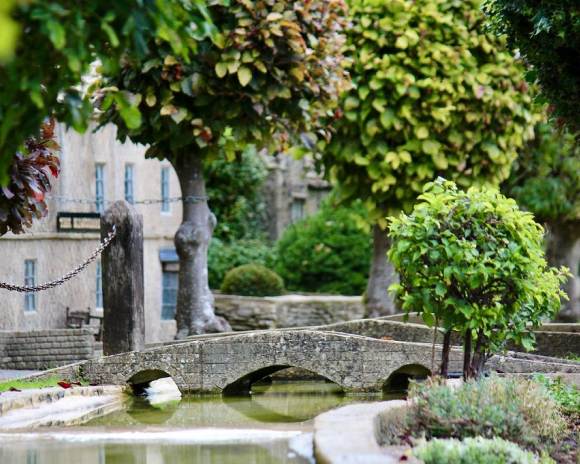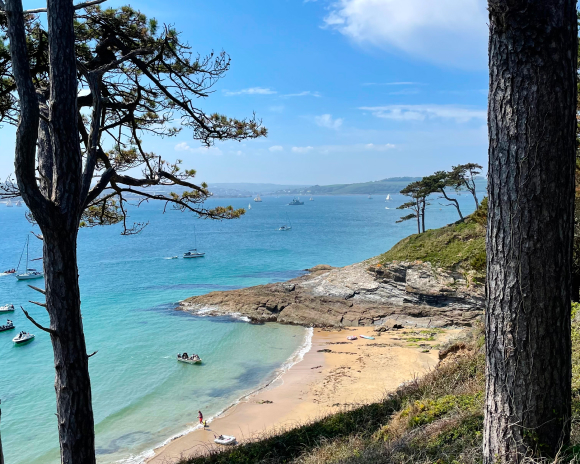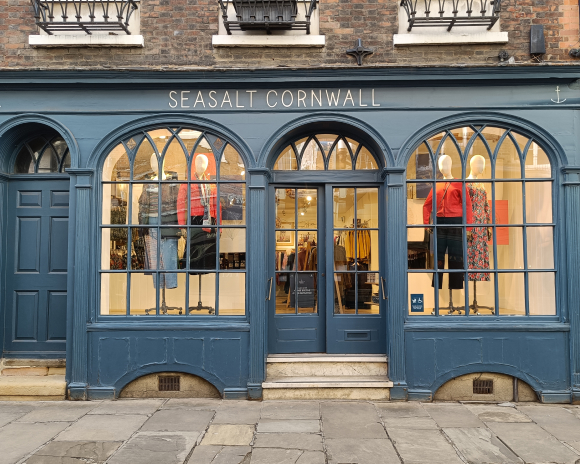Glorious Gardens in Cornwall
Discover where our Seasalt artists find inspiration for botanical prints.29/03/19


Cornwall’s mild climate means it’s long been a haven for gardeners. The rich botanical heritage of our coastal home is rooted in history, when gardening enthusiasts sponsored plant-gathering expeditions across the globe.
The subtropical climate here nurtured the species that were brought back, helping them thrive far from home. The result is an abundance of great gardens bursting with plants from far-flung corners of the globe. From the spiky palms of Heligan to the great gunnera of Trebah, each season our designers turn to the winding pathways between leaves, fronds and flowers to find inspiration for new print designs.




Laurel maze, planted by Alfred Fox in 1833, with a thatched summerhouse at its centre. Chusan palms at Glendurgan Garden, Cornwall. Image Credit: National Trust
Glendurgan Gardens
Nestled just outside Falmouth, the National Trust’s Glendurgan Gardens are set within three small valleys. You’ll find routes and walks for everyone, meandering through exotic plants. In the lower valley, there are jungle-like leaves while sun-seeking species enjoy the higher banks. Stroll through camellias, magnolias and carpets of wildflowers to a sheltered beach at the bottom of the gardens, or wander through the laurel maze.


Trebah Gardens
Just around the corner from Glendurgan Gardens, you’ll find Trebah. Bursting with colour, Trebah is a subtropical garden with a stunning coastal backdrop. With over four miles of pathways to explore, there’s plenty to see and do, and there’s even a private beach on the edge of the Helford River. If you visit in early spring, you’ll see a colourful array of 100-year-old rhododendrons, magnolias and camellias.




Walking in the garden at Trelissick, Cornwall. Image Credit: National Trust
Trelissick Estate
Located near the coastal village of Feock, the National Trust’s Trelissick Estate is set on its own peninsula. With miles of open parkland, dappled woodland, a beach and expansive views over the Fal estuary to Falmouth, there’s lots to explore and you can even take your four-legged friend along, too.




Image credit: The Lost Gardens of Heligan
The Lost Gardens of Heligan
The Lost Gardens of Heligan near St Austell is 200 acres of paradise for plant-lovers and wildlife enthusiasts. After being abandoned and overgrown from 1914, the gardens were rediscovered in 1990 by Tim Smit and John Willis, and opened to the public two years later.
Today, Heligan is one of the best–loved gardens in Britain and has won numerous awards. It’s a place to visit all year round: with a range of different gardens to explore as well as the wider Estate with woodlands and a working farm, there’s always something to enjoy come rain or shine.




Trerice House & Gardens
Located near Newquay, Trerice boasts both a beautiful house and gardens. Small but perfectly formed, there’s a formal Elizabethan garden, an orchard where daffodils bloom in spring and a meadow full of wildlife. When you visit, don’t forget to take a guided tour around the Elizabethan manor to learn more about the history of this beautiful spot.


Penrose
Penrose is an area around Loe Pool, Cornwall’s largest natural freshwater lake. With woodland and sea-swept stretches of coastline as well as open parkland that you can explore on foot, bike or horseback, Penrose is the perfect day out. If you visit in late April or May, you’ll see a carpet of bluebells across Penrose’s woodlands and fields.




Image from @EdenProjectCornwall on Instagram
The Eden Project
The Eden Project is just outside of St Austell and offers a wealth of activities throughout the year.
Nestled in a former clay pit, the Eden biomes house everything from a lush rainforest and exotic plants to exhibitions and horticultural stories. The Eden Project also hosts summer concerts and family events, making it the perfect destination for longer, warmer days.




